BARNEY GOOGLE AND SNUFFY SMITH
Billy DeBeck, Fred Lasswell, and John Rose
Preamble: In our recent post about George McManus’ famed Bringing Up Father (“Maggie and Jiggs”), which expired at the age of 87, I hazarded the assertion that only The Katzenjammer Kids (born December 12, 1897) and Gasoline Alley (November 24, 1918) at ages 112 and 91 were strips of comparable longevity. Maybe not. Probably not. Definitely not. And to some extent, even my baldfaced statement is itself dubious: The Katzies, after all, is a Sunday only strip, so its longevity is not comparable in publication or, say, in number of drawings to that of Gasoline Alley, which runs seven days a week. But in the pulse-pounding excitement of the moment that caused me to overlook this distinction, I’d forgotten about Barney Google. Admittedly, Barney Google has run under at least three different titles and has changed its lead character, but I still think of it as the same strip. And it passed its 90th anniversary last summer. So Barney Google, more than The Katzies, is a long-lived feat akin to Bring Up Father. So, still in the grip of anniversary festivities, here’s the Barney Google story.
WILLIAM MORGAN DeBECK was a cartooning genius who made a mark in the history of the medium by renewing his creation again and again, each time with a more inventively hilarious novelty than before. Born April 16, 1890, on the South Side of Chicago, he was the son of Louis DeBeck (a French name, originally spelled DeBecque), a former newspaperman who had taken refuge in the offices of Swift and Company, and Jessie Lee Morgan, a farm girl who had worked as a school teacher. After graduating from Hyde Park High School, young DeBeck enrolled in the Chicago Academy of Fine Arts, intending to become a painter in the Dutch Masters tradition, but he was selling cartoons to finance his artistic aspirations and was successful enough at it to land a job in 1910 with a weekly theatrical paper, Show World, whereupon he gave up painting.
Growing up, Billy’s talent was shaped by his admiration for the cartoons of John T. McCutcheon, the legendary editorial cartoonist at the Chicago Tribune, and Clare Briggs, who drew down-home cartoons under a rotating series of titles—When A Feller Needs A Friend, The Days of Real Sport, Ain’t It A Grand and Glorious Feelin’? Although DeBeck could produce copiously cross-hatched illustrations in the manner of Charles Dana Gilbson, most of his early newspaper work was in the fustian cartoony vein of the idols of his youth.
Like many newspaper artists of his generation, he bounced around, moving from one paper to another as better opportunities presented themselves. He left Show World within a year to take a position at the Youngstown Telegram in Ohio; after two years, he departed in late August 1912 for the Pittsburgh Gazette-Times, which he left two years later for what he imagined would be greener pastures. For the papers, DeBeck did the routine drawing assignments that fell to staff artists—sports cartoons, a few politicals, borders around photographs, spot illustrations for newsstories and columns and the like. The greener pastures he took off for, humor magazines Judge and Life in New York City, weren’t as verdant as he’d hoped, and by May 1915, he was back in Pittsburgh, teaming with a fellow named Carter to launch a newspaper feature syndicate and a mail order cartoon instruction course.
Not much green there either, so DeBeck returned to Chicago, where, in December 1915, he joined the staff of the Chicago Herald while moonlighting a comic strip, Finn an’ Haddie, for the Adams Syndicate. Finn an’ Haddie went nowhere, but DeBeck’s next comic strip concoction, Married Life, about a bickering couple named Aleck and Pauline that started December 9 at the Herald within days of his hiring, attracted the attention of press lord William Randolph Hearst, who, according to Brain Walker in his 75th anniversary reprint tome, Barney Google & Snuffy Smith, was so smitten with DeBeck’s work that he bought the Herald in order to secure the cartoonist’s services. Hearst merged the Herald with his Chicago Examiner, and DeBeck’s Married Life continued under the new masthead. DeBeck added several other cartoon features, mostly on the sports pages of the paper, taught night classes at the Chicago Academy of Fine Arts, and “became something of a local celebrity,” Walker said, going on to describe one of the antics that earned DeBeck his standing:
“Legend has it that on Armistice Day, November 11, 1918, DeBeck rode a white horse through the saloons of Chicago and after his night of revelry fell asleep on the desk of Arthur Brisbane, [Hearst’s fearsome factotum of all jobs, then serving as] editor-in-chief of the Herald and Examiner. The next morning, Brisbane chased Billy out of his private office, but Billy returned shortly after, interrupting an important meeting to retrieve his socks, which were neatly tucked away in Brisbane’s dictating machine.”
DeBeck’s next notable antic was to invent another comic strip, which was launched June 17, 1919, on the sports page. Entitled Take Barney Google, For Instance, this new endeavor partook somewhat of the domestic travails that distinguished Married Life but with a difference: it concentrated on the husband’s fixation with the sporting world in defiance of his wife’s opposition. Despite all that henpecked Barney could do, the strip just limped along. Shortening the title to the name of the protagonist didn’t help much either. Then on July 17, 1922, DeBeck arranged for Barney to acquire a race horse named Spark Plug, and the sad-faced nag, most of whose anatomy was hidden underneath a moth-eaten shroud-like horse blanket, became, as Walker puts it, the Snoopy of the Roaring Twenties. Barney entered his sorry steed in a race, and DeBeck, drawing with a loose but confident line and intricately hayey shading, quickly discovered the potency of a novelty in comic strips of the day—continuity, which, at the time, almost no comic strips indulged in.
The suspense inherent in a continuing story captivates readers, and so for most of the ensuing decade, DeBeck kept his audience on tenterhooks by entering Spark Plug in a succession of suspenseful contests, the outcomes of which were never certain (some of them, surprisingly, Spark Plug won). DeBeck milked the suspense inherent in continuity for all he could squeeze out of it: to prolong the tension, on some days the strip appeared as a sort of “editorial cartoon” in which the current suspenseful predicament was dramatized in visual metaphors and symbols, heightening the anxiety by restating its terms without bringing matters any closer to resolution. The strip increased in readership and circulation, and it was relentlessly merchandised. In 1923, songwriter Billy Rose contributed to its notoriety with the song, “Barney Google,” which became a smash hit due, doubtless, to an irresistible refrain that referred to a conspicuous feature of Barney’s visage—“Barney Google with the goo-goo-googly eyes.”
Barney’s eyes stayed the same size for as long as he appeared in the strip, but the rest of him didn’t. When the strip started, he was as tall as his wife, but he shortly started losing altitude, and by 1921, Barney was a gnomish wart, a scrunched-down jot of his former tittle, a pipsqueak mote of a homunculus—a perfect comic runt of a character who looked as outlandishly funny as his obsessions were fanatical. Among the latter, a propensity to admire chorus girls and other beautiful manifestations of the opposing sex.
Hearst had suggested, in the strenuous manner for which he was renowned, that DeBeck put a pretty girl in the strip, but DeBeck resisted, briefly, claiming he couldn’t draw pretty girls. As it turned out, this was one of the few things in comic stripping that DeBeck was wrong about, and when he finally relented and acquiesced to the boss’s dictum, the girl was as beautiful and voluptuous as any in the funnies.
“And then the fun began,” DeBeck recalled. Quoted by Walker, he unfolded the story. DeBeck said he was at a loss for a name for this paragon of pulchritude. “Muriel, Jane, Eliza, Annie—none of them fit,” DeBeck said. “Stymied no end,” he finally hit on a pet name instead of a proper one: Sweet Mama.
“Wow!” DeBeck went on. “That started something. Letters poured in. The readers wanted to know where her child was. How could a single gal be a mama? Was Barney the father, etc., etc.? We lost several clients. Brisbane phoned. ‘Cut out Sweet Mama,’ he demanded. ‘Go back to Spark Plug.’ But in two short weeks the expression ‘Sweet Mama’ had swept the country. Songs were written about ‘Blonde Mamas,’ ‘Red Mamas,’ and so on. Brisbane phoned again. ‘Put Sweet Mama back in the strip,’ he said—‘don’t you know when you’ve got sump‘n?’”
Thereafter, DeBeck went on, he started regaling his readers with colorful invented argot. With such linguistic stunts, the inventive cartoonist proved perfectly capable of contributing to popular culture single-handedly without Billy Rose’s help. In the strip, DeBeck coined a parade of expressions that captured the public’s fancy: in addition to sweet mama, DeBeck gestated heebie jeebies, horsefeathers, hotsy totsy, osky wow wow, and bughouse fables, to cite a few.
Somewhere amid a procession of sweet mamas, Barney’s wife (whom he had called “sweet woman” in their inaugural appearances) faded from view. Once Barney became obsessed with Spark Plug and horse racing, Mrs. Google seldom showed up. And Barney never mentioned her—for months, sometimes years. An unnamed daughter of a somewhat preschool age likewise vanished from view (she, within hours of the strip’s debut). The sweet woman would wander back into the strip every once in a great while, and on one of her return engagements, in 1928, she was married to Horseface Klotz, a friend of Barney’s to whom Barney then explained that he’d been married to her long ago. Clearly, he no longer was. Henceforth, Barney was an unapologetic bachelor. Not that he’d ever felt like apologizing for his wandering eye: he didn’t, and he even told a pretty girl on a park bench that he was a “confirmed bachelor” as early as October 20, 1919, less than six months after his debut as a henpecked sports fanaddict (sic).
As an unabashed philanderer, Barney broke one of syndicated cartooning’s most sacred taboos: comic strip husbands weren’t allowed to cheat on their wives. Nor were husbands permitted to beat their wives. Just down the page from DeBeck’s strip was George McManus’s in which Maggie regularly pelted her husband with crockery; but Jiggs wasn’t permitted to fight back. Barney, however, got away with playing around while his wife stayed home and played house.
Maybe it was because he was so short: how realistic was it to suppose that such a shrimpboat could fascinate beautiful women? And if Barney’s dalliances weren’t realistic, they couldn’t, perhaps, threaten the institution upon which all civilization was founded—marriage and the family. Or maybe Barney got away with it because he no longer had any visible children; neither did Debeck.
Not even the storied licentiousness of the Jazz Age undermined syndicate prohibitions. But it was the Golden Age of Sport, as proclaimed by Grantland Rice, the dean of American sports writers—the age of Jack Dempsey, Man O’War, Babe Ruth, Bobby Jones, and Red Grange; the age of bathtub gin, flappers, Tin Pan Alley, cross-word puzzles, mahjong, and flag-pole sitting. And maybe the pervasive sense of play permitted players at indoor sports as well as outdoor sports. DeBeck himself was an avid sports enthusiast. He regularly went to prize fights, race tracks and baseball stadiums. Later, he became a dedicate golfer. His was “a man’s world,” as Walker puts it, and Barney Google appealed to just that crowd. “Barney was the Everyman of the Jazz Age. ... His adventures were the male fantasies of his loyal readers. DeBeck’s creation is a reflection of their hopes, dreams and failures.” And so Barney got away with it.
DeBeck embodied some of those male fantasies (no failures) as well as the general frenetic ambience of the age. He was, seemingly, in constant motion, showing up at events in San Francisco, then Seattle, then Washington, D.C. He hobnobbed with politicians, star athletes, actors, and authors. Newspapers recorded in pictures and prose his peripatetic comings and goings. And how could he be a wandering playboy and still produce a daily comic strip? Luckily, he was a fast worker. He might evade his deadline responsibilities for days at a time, but then he’d sit down at the drawing board and crunch out two weeks of dailies and a couple Sundays in a single non-stop sixteen-hour stretch. After blocking out a strip with rough pencil sketches of the characters to show their positions, he went directly to pen and ink, drawing “straight ahead”—that is, without knowing much in advance where, exactly he was going with a particular strip or storyline. He always claimed the last thing he drew in any strip were the dots in Barney Google’s goo-goo-googly eyes. Putting a period to each release, we might say.
In marriage, DeBeck was similarly capricious: he married three times, twice, in succession, to the same woman. But his last marriage, in 1927 to Mary Louise Dunne, settled him down. Somewhat. They moved to Paris and lived there for two years, DeBeck mailing his drawings regularly to King Features in New York.
The circulation of Barney Google had begun to slip by 1934, and the resourceful DeBeck decided to change the direction of the strip, shifting its locale from the city and the race track to the backwoods of Appalachia, joining numerous other popular entertainments of the thirties in acquainting a mainstream American audience with hill country culture. What prompted Americans’ apparently sudden interest in hillbillies is open to speculation. My guess is that it stemmed from radio broadcasts, since the mid-1920s, of country music in the weekly “National Barn Dance” originating in Chicago (1924) and “Grand Olde Opry” from Nashville (1925). As the country’s addiction to radio grew (particularly during the Depression when the appliance offered free entertainment), so did the popularity of country music—and an interest in the place where country music was presumed to originate, Appalachian hill country. DeBeck caught on by autumn 1934; Al Capp had preceded him that summer with Li’l Abner.
In the early fall that year, Barney Google inherits property in the mountains of North Carolina, and when he journeys there to inspect his estate, he encounters on November 17 a cantankerous hillbilly named Snuffy Smith and his wife Loweezy and an ensemble of picturesque characters. After Snuffy’s debut, most of DeBeck’s stories were set in an imaginary Appalachian community called Hootin’ Holler.
Although the strip was entirely fictional, DeBeck took pains to give his work an authentic foundation. According to comics scholar M. Thomas Inge, “in preparing for the new episodes, DeBeck traveled through the mountains of Virginia and Kentucky, talked to the natives, made numerous sketches, and read everything he could lay hands on that treated mountaineer life.” DeBeck collected books on the subject, building an impressive library of the literature and lore of Appalachia. But the help he had in refining the lore he collected came from a 17-year-old kid he’d found in a toilet.
FRED LASSWELL, JR. WAS BORN July 25, 1916, in Kennett, Missouri, son of Fred Lasswell, movie theater owner and farmer, and Nellie Forence Waldridge. Fred, Sr. was in the U.S. Navy when his son was born, having sold his theater in Campbell, Missouri, to enlist immediately upon the U.S. entrance into World War I in April 1916. After the War, he moved his family to Gainesville, Florida, where he bought a ten-acre chicken farm. The farm supported a horse, a wagon, a plow, a cow, a dog, a cat, and 2,000 white leghorn chickens. But no electricity, tele-phone, radio, hot or cold running water. “We had an outhouse with a croker sack hanging where the door ought to be,” Lasswell remembered. “In some parts of the country, a croker sack is called a gunny sack.”
He would remember his rural roots all his life. “I remember sitting on our front porch at twilight time in a squeaky old rocking chair,” Lasswell wrote once. “Way off in the distance, you could hear hound dawgs howlin’ and yappin’ like they had just treed a big ol’ fat ’coon. And I’ll never forget the mournful cry of the whippoorwills. And you could smell a pine stump smouldering ’way off somewhere. Once in a while, if you listened very carefully, you could hear the chatter of crickets and the frogs croaking in the creek. The world shore was a purty place in them days.”
But in 1926, the Lasswell family became city dwellers. They moved to Tampa, Florida, where young Fred enrolled in Seminole Heights Elementary School. Starting at age twelve, he drew cartoons and comic strips for his school newspapers. Through high school, he earned money with a Tampa Daily Times paper route and by hawking the rival Tampa Morning Tribune on the streets in Ybor City, which, at the time, was the venue of much of Tampa’s nightlife, including saloons, gambling halls, and brothels—Tampa’s “recreational area,” as Lasswell called it in later years: “In a thirty-square-block area, there were a whole lot of small houses side by side, where young ladies lived. And, since it was hard times, four or five of them would share the same house.”
Fred quit school just before graduating and went to work part-time in the art and engraving department of the Tampa Daily Times for awhile, freelancing simultaneously, then found a job in an ad agency. “Space was at a premium at the agency, so I wound up working in the men’s room,” he said. “I sat there on the toilet seat, with the lid down and a drawing board on my lap.”
He was perched right there in late spring 1934 when he got a phone call from Billy DeBeck. In those days, DeBeck wintered at St. Petersburg, and he was golfing near Tampa with fellow cartoonist Frank Willard (Moon Mullins), baseball greats Paul and Dizzy Dean, and sports writer Granny Rice when he saw a poster that Fred had lettered. He wanted a letterer for Barney Google, and he soon hired Fred. When DeBeck went back to New York, Fred went with him. When DeBeck and his wife rented a home in Great Neck, Long Island, Fred moved in with them. “Wherever they moved, I lived with them,” he said. And they lived in a lot of places over the next few years. Great Neck, Kings Point, Port Chester, Lake Placid and St. Petersburg.
DeBeck undertook Fred’s education. He recommended books for him to read. And he directed the youth to copy accomplished pen-and-ink artists—Charles Dana Gibson, Phil May, and others—including his own work in the comic strip, which he made Fred copy, line for line. And Lasswell also attended Art Students’ League in New York and the Phoenix Art Institute.
Snuffy Smith’s Hootin’ Holler could have been Lasswell Land: Lasswell was “country.” And he undoubtedly helped DeBeck to conjure up the aura of the new hillbilly locale. Once
DeBeck moved the locale of the strip to the backwoods, he indulged his fascination with language to imbue his creation with colorful expressions that reflected the lingo of the hills. Lasswell reported that one of his first tasks involved assisting his boss in the research. DeBeck went through books about the hill folk and blue-pencilled words and phrases; then Lasswell entered all of these into a “log book,” which DeBeck later consulted for ideas and vocabulary. The two most heavily annotated authors, Inge notes, were Mary Noailes Murphree and George Washington Harris. And in the latter’s Sut Lovingood’s Yarns, Inge says, “there isn’t a page not heavily annotated.” DeBeck borrowed copiously from Harris for the dialect spellings of such words as “hit” (for “it”), “hyar” (“here”), “mought” (“might”), “orter” (“ought to”), “propitty” (“property”), and so on.
Aided, doubtless, by his country-boy assistant, DeBeck also concocted entirely new expressions that had the ring of Appalachian locutions—daider’n a door-knob, time’s a-wastin’, a leetle tetched in the haid, shif’less skonk, bodacious idjit, ef that don’t take th’ rag off’n th’ bush, and others. And many of these (like “balls o’fire” and “jughaid”) joined “heebie jeebies” and “Sweet Mama” in the popular slang of the day.
Lasswell started contributing gags and other ideas to the strip almost at once, but it wasn’t until 1941 that DeBeck gave him a chance to solo. Lasswell wrote and drew a six-week sequence (February-March) in which 30,000 soldiers go to Hootin’ Holler for practice maneuvers and encounter hostile hillbillies, who have mistaken the uniformed legions for “revenooers” bent on destroying the local distilling business.
Despite the authenticity of the strip’s language, the stories and situations partook of the stereotypical portrayals of mountain men and women in the literature about the region. Mountain men carried rifles wherever they went, and Snuffy was always willing and able to “bounce a passel of rifle balls off’n punkin haids” of miscreants in his path. Laziness, chicken thievery, stills of corn whiskey, ignorance, illiteracy, belief in ghosts and wood goblins and other supernatural creatures, feuding families, weddings of the offspring of feuding families, and stubborn individuality are frequent motifs in DeBeck’s Snuffy Smith tales. Snuffy himself is the epitome of self-centered, opinionated indolence.
But Snuffy became so popular with readers that by the end of the 1930s, he was given equal billing with the eponymous star when the strip was re-titled Barney Google and Snuffy Smith. The hillbilly years of the strip inspired two motion pictures and numerous animated cartoons.
During World War II, both Barney and Snuffy “joined up,” as the saying goes. Snuffy first. After days of rejection (he was too short and had no teeth), he finally got himself into uniform in the Army on November 13, 1940—well before the U.S. had even entered the hostilities. But the draft had been introduced in September that year, so Snuffy’s enthusiasm was in step with the times. (He was motivated, we suspect, more by the promise of “thutty dulers a month” than by rampant patriotism, but we’ll leave that aside for now.) Barney went into the Navy but not until a year later, September 1941. Again, before we were actually at war. The strip was popular with service personnel because its protagonists were both in the military, but Snuffy was on stage more than Barney and popularized the expression “yardbird” for a kind of military camp loafer.
In 1942, DeBeck was diagnosed with cancer, and by late spring, he could no longer work. His signature last appeared on a daily strip dated July 4; his last signed Sunday strip, August 2. When DeBeck died in November, Lasswell, who had tried to join the Navy the day after Pearl Harbor was attacked but failed the physical because of poor eyesight, was making his contribution to the war effort in Africa, working as a radio operator for Pan American Airways. He’d been away from the strip since August, but because he’d been DeBeck’s assistant for almost nine years, it was natural that the syndicate asked him to return to the U.S. to continue the feature. Lasswell quit Pan Am as fast as he could and returned to Snuffy’s hill country. Later, he went to Washington, D.C., to join the Marines, which he did in order to work on Leatherneck magazine for which he created a special strip, Hashmark. His eyesight was presumably no longer a problem by this time in the War’s progress. Evenings in his apartment, Lasswell cranked out Barney Google and Snuffy Smith. The first strip to carry his signature appeared on March 8, 1943.
While Lasswell labored in the nation’s capital, in the syndicate bullpen in New York, staff artist Joe Musial (who had been doing the daily strip after DeBeck became too ill to continue it) produced the Sunday strips and, sometimes, dailies until the end of the War. Then Lasswell took over entirely. Acting upon the advice of syndicate officials, Lasswell gradually eased Barney out of the strip to concentrate on the more picturesque Snuffy.
It was a successful ploy. The strip was faltering when Lasswell took it over. It had about 200 subscribers and was losing clients steadily. But the subscription list had climbed to more than 500 by 1964, the year Lasswell won the Reuben as the National Cartoonists Society’s “cartoonist of the year”; and at its 70th anniversary in 1989, Barney Google and Snuffy Smith was in nearly 900 newspapers worldwide.
Incidently, the Reuben, a heavy metal statuette of a pile of nondescript but definitely cartoony characters attempting to array themselves as a human pyramid, was named after its designer, Rube Goldberg, the first president of the club, but it was not always the trophy or the name of the award NCS conferred upon the “cartoonist of the year.” Initially—and for the first eight years the award was presented, 1946-1953—the trophy was a handsome silver cigarette box, its lid engraved with pictures of the characters in Barney Google and Snuffy Smith. When DeBeck’s widow, Mary, heard about the formation of NCS in 1946, she suggested that the Society institute an annual award recognizing the cartoonist who, in the judgment of his fellows, was the best of the year. She would furnish the prize, she said, if it could be awarded in the name of her late husband. In fond memory of DeBeck, the Society accepted her offer. Known officially as the Billy DeBeck Memorial Award, it was also briefly dubbed “the Barney”—in imitation of the film industry’s practice of referring to its most prestigious prize by an informal first name.
DRAWING UPON HIS OWN BACKGROUND to maintain the rural folksiness of the strip, Lasswell felt at home with the hillbilly folk of Snuffy Smith’s Hootin’ Holler mountain country and was therefore able to make his own distinctive contribution to the saga of the strip, thereby making it entirely his own creation. As Walker says: “He took a comic strip that had earned a place in history and developed it into an enduring classic.”
“I have great empathy for these folks and critters,” Lasswell wrote. “My folks had come out of a country atmosphere, so I was very comfortable with country people. I just fell into the spirit of the type of people Snuffy and Loweezy were. I really don’t know beans about the racetrack world of Barney Google and Spark Plug, and that is why I changed it to a Snuffy strip exclusively.”
Lasswell brought Barney and Sparky back from time to time—“for the old folks,” he said. But his signal effect upon the strip grew out of his own personal history in rural settings and his sympathy for rural America. Says Walker: “This sensibility is what makes Fred Lasswell’s contribution to the legacy of Barney Google and Snuffy Smith uniquely his own. The beautifully rendered backgrounds of Fred’s Hootin’ Holler evoke a rural ambience that is distinct from Billy and Barney’s urban milieu. Fred has also established a loving relationship between Snuffy and Loweezy that gives the strip a feeling of warmth and tenderness.”
At first, Lasswell drew in DeBeck’s style but slowly adopted a bolder line, better suited to the minuscule reproduction comic strips faced increasingly in the years after the War. He introduced a host of intriguing characters for his post-war stories (most memorably for me, the creations of the 1950s—Tiger Li’l, a sexy nightclub dancer; Tieless Ty Tyler, the necktie tycoon; and Riddles Barlow, who married the winsome Cricket Smif). In the mid-fifties, he cannily gave up long continuities that had characterized the strip for decades and converted the strip to gag-a-day to stay in step with the trend in the industry.
Lasswell died at about 6:30 a.m. on Sunday morning, March 4, 2001, of a heart attack while at home in Tampa, Florida. He was 84. He had been meeting the syndicate deadline for 58 years almost to the day. In longevity, Lasswell joins a very tiny band of his peers—Edwina Dumm, Paul Robinson, Chester Gould, Charles Schulz, Mort Walker, Milton Caniff, to name a few of the few record holders in the profession. In reaching this milestone, Lasswell is second only to Australia’s Jim Russell, who, at the time of Lasswell’s death, had been doing The Potts for 62 years.
Fred Lasswell’s achievement with the strip must be measured in more than simply the number of years he did it. He also worked another minor miracle: inheriting the strip from its creator in 1942, Lasswell managed to improve upon its original conception while maintaining its essential ambience —a rare almost unprecedented accomplishment. Much of the difference between the two incarnations lies in the difference between continuity and gag-a-day. DeBeck was expert at milking comedy out of suspense with a seemingly unending string of cliffhangers and tantalizers. But Lasswell gave the strip personality and heart as well as humor.
FRED LASSWELL WAS ONE OF THE GRAND MASTERS of the medium. And he was a memorable and laudable man. Lasswell was “Uncle Fred” to his colleagues in the National Cartoonist Society (NCS). He was an actively contributing member to the convivialities of the group for almost its entire existence, and no Reuben Banquet was complete without some shenanigan from Uncle Fred. Even the last year of his life when he didn’t attend, an unprecedented occurrence, he supplied punchlines for others standing at the microphone: all you had to do was refer to Uncle Fred— to one or another of his well-known proclivities—and you could get a laugh. Absent in person, he was still present. His picture was on the cover of the program booklet. And one of the souvenirs of the event was a flip book featuring Uncle Fred in action.
He was honored by NCS in other, more formal, ways. In 1964, he established a record when he was awarded both the Reuben statuette and the category plaque for “best humor strip.” And he is the only cartoonist to have twice (1984 and 1994) received the Elzie Segar Award “for unique and outstanding contributions to the profession of cartooning.”
As the news of his death spread through the Web, e-mail lists recorded the responses of other cartoonists.
“Uncle Fred was a dear friend to NCS,” said Daryle Cagle, then NCS President. “He was a treasure, and we are all richer for having known him.”
“Now there was a cartoonist!” Paul Fell said. “Boy, talk about a career. Uncle Fred was the prototype for cartoonists if ever there was one.”
Uncle Fred had a way of making anyone he met feel at ease—as if they were friends of long standing. “Anyone who met him, loved him instantly,” said Mark Szorady.
In the NCS membership Album, Uncle Fred is the only one to list not only his mailing address but his fax number and his phone number, signifying, without qualm or quibble, that anyone should feel free to call him anytime.
“He took me in like I was a long lost nephew,” Ron Evry said. “But he was more than a fun guy and an active member of NCS. He was a link to a world of cartooning that no longer exists.”
He was, in short, the last of the old time comic strip cartoonists, and his passing cut the umbilical cord of direct experience that connects us to our past. Without Uncle Fred around, we shall have to imagine more because we no longer have the testimony of an eye witness.
And his strip was always an exemplar of the cartoonist’s art. In virtually every Snuffy Smith strip I ever saw, the pictures contributed as much to the punchline as the words. In a time when so much comic strip humor is entirely too verbal, the pictures serving only to identify the speakers and time the gag, Lasswell’s strip blended the verbal and the visual into a seamless comedic whole in the best tradition of the artform. Typically in Snuffy, the words set up the situation in the opening panels; and the picture in the concluding panel supplied the joke. Neither words nor pictures alone without the other were funny; blending together, they created a new hilarity every time.
LASSWELL’S SUCCESSOR, John Rose, had been assisting on the strip since mid-1998, inking Uncle Fred’s pictures. Born November 15, 1963 in Covington, Virginia, Rose graduated from James Madison University in 1986 with a degree in art and art history. For a time, he freelanced sports cartoons for newspapers in Manassas and elsewhere in Virginia, then in 1993, he was hired by the Daily News-Record in Harrisonburg, joining the other Byrd Newspapers of Virginia to draw political cartoons for the Shenandoah Valley 8-paper chain. And since 1988, Rose has produced a weekly children’s cartoon/activity page, Kids’ Home Newspaper (syndicated since 1991), and he’s illustrated seven children’s books. When Lasswell died, Rose took over the strip that still carries the joint title, Barney Google and Snuffy Smith, conferring an accolade on both Rose’s predecessors on the feature.
While Rose produces a competent imitation of the appearance of Snuffy and his cohorts in the hills, the strip’s gags are almost always verbal jokes. Uncle Fred cannot, it seems, be so easily aped as we might suppose. And that’s a comforting thought: one of a kind is, for perpetuity, one of a kind.
Lasswell, despite his hayseed demeanor, was quite at home in the high tech era, maintaining a state-of-the-electronic-art studio. He developed his own lettering font on a Mac long before most other cartoonists did and established a web page very early in the cyberspace age. And he produced a videodisc series on “how to draw” cartoons (one in Spanish) and a bilingual laserdisc with a barcoded workbook and a hypercard stack for computers.
He was always innovating. In the 1940s, he produced a comic book for the blind using a Braille-inspired system. And in 1962, he obtained a patent for a citrus harvesting machine he’d designed in 1958 and licensed the idea to International Harvester.
Still, the challenge was a daily comic strip. One a day, every day.
“The gut of a comic is in the characters themselves,” he said several years before he died. “If you don’t have a bang-clang gag or something that’s all polished and beautiful, then just emphasize the character because that way people get to know them.”
And that’s how we got to know Fred—through Snuffy and Loweezy and all the folks down at Hootin’ Holler. Like them, Fred was funny, picturesque, and loving.
“If you loved comics,” comics scholar Richard Olson said, “Fred loved you.”
It was as simple as that. Still is.
*****
Virtually all of the information and anecdote in the foregoing was gleaned from Brian Walker’s memorable book, which includes, in addition to the insights of its text, a healthy sampling of how the strip looked through the years and a smattering of visual references to the events in the strip during those years, plus photographs and miscellaneous art. The book, although scarce, can still be found on the Web; try AddAll.com. Now here’s some pictorial history to accompany the foregoing plethora of prose.
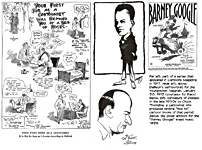 |
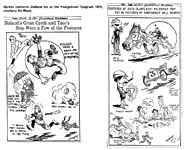 |
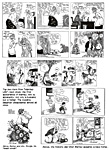 |
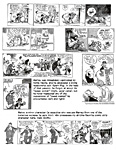 |
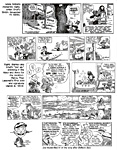 |
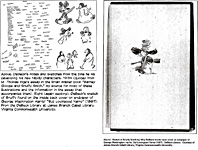 |
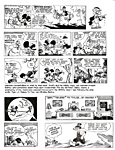 |
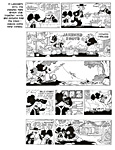 |
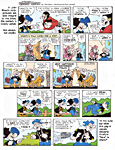 |
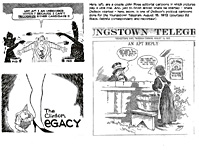 |
